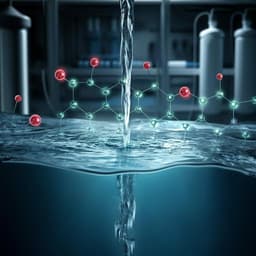
Chemistry
Graphene transistors for real-time monitoring molecular self-assembly dynamics
M. Gobbi, A. Galanti, et al.
Experience the forefront of nanotechnology with groundbreaking research by Marco Gobbi and colleagues, who demonstrate how graphene devices can monitor molecular self-assembly dynamics in real-time. This innovative approach offers unprecedented sensitivity and speed, paving the way for new discoveries in 2D molecular organization.
~3 min • Beginner • English
Introduction
The study addresses how to monitor, in real time, the dynamics of molecular self-assembly at solid/liquid interfaces, which dictates functional properties of surfaces but is difficult to probe due to convolution of interfacial and bulk processes. While STM offers sub-nanometer spatial resolution for on-surface assemblies, it probes tiny areas, has limited temporal resolution (10–100 ms per frame or slower for assemblies), and cannot capture ensemble dynamics across macroscopic areas. The authors hypothesize that the ultrahigh surface sensitivity of graphene field-effect transistors (GFETs) can provide a purely electrical, real-time readout of interfacial self-assembly dynamics, disentangled from bulk photoisomerization/thermal processes. They use a spiropyran (SP) derivative that photoisomerizes under UV to merocyanine (MC), which forms a metastable adlayer on graphene, modulating graphene’s conductance like a gate. By tracking current over time during UV on/off, they aim to resolve formation and desorption kinetics of the MC self-assembled monolayer.
Literature Review
Prior work has shown self-assembly on surfaces yields ordered 2D structures with tunable functions, commonly visualized by STM (e.g., nucleation, rearrangement, light-responsive assemblies). However, STM is limited to small areas and modest frame rates, insufficient for ensemble dynamics across billions of molecules. Electrical devices have monitored single-molecule reactions and DNA hybridization in real time, but not complex ensemble self-assembly on surfaces. Photochromic systems, including spiropyrans and diarylethenes, have been studied at interfaces, revealing cooperative and surface-induced effects, but without electrical monitoring of the assembly dynamics. This work builds on these insights by introducing GFETs as sensitive, noninvasive probes of interfacial assembly kinetics.
Methodology
Materials and system: A spiropyran (SP) derivative bearing an octadecyl chain (promoting lamellar self-assembly) in 1-phenyloctane solvent (negligible absorbance at 365 nm). Under UV (365–367 nm), SP photoisomerizes to the zwitterionic merocyanine (MC), which thermally reverts to SP.
Optical characterization: UV–Vis spectroscopy at 26 °C using λ = 367 nm LED (FWHM 7 nm), power density P = 0.5 mW cm^-2. Absorbance at 590 nm (A590) monitored in 1 mm path cuvettes to follow SP→MC during irradiation and MC→SP in dark. Time points: t = 1–150 s (various). Kinetics fitted with monoexponential functions; τ_hv,0 extracted as the photoisomerization time constant in bulk solution. Concentration range spanned ~10 µM to 4 mM; initial concentrations denoted C0.
STM at solid/liquid interface: HOPG substrate with 6 µL SP solution (C0 = 1.8 mM). Ambient STM (Veeco Multimode III) in constant current mode with Pt/Ir tips. UV (365 nm, ~2.0 mW cm^-2) irradiation in situ to induce SP→MC; imaging before/after irradiation to visualize MC assembly formation and subsequent desorption. Image processing with Gwyddion; unit cell parameters via Fourier analysis. Time resolution limited by frame acquisition (~30–34 s); movies captured over minutes to track desorption.
Graphene device fabrication and electrical measurements: Back-gated GFETs on SiO2(90 nm)/Si: (i) exfoliated graphene with Au contacts; (ii) commercial CVD graphene devices (GFET S20, Ni/Al contacts). Devices cleaned (acetone, NMP, IPA). A droplet (6–8 µL) of SP solution in 1-phenyloctane cast on device; UV irradiation with same LED (λ = 367 nm, P = 0.5 mW cm^-2) perpendicular to device. Electrical bias V_DS = 10 mV; V_G = 0 V for time traces; transfer curves I_DS–V_G recorded to observe neutrality point shifts. Channels with W = L = 50 µm and 100 µm (same W/L ratio) tested; up to three devices measured simultaneously under a shared droplet. Time-resolved current sampled at 100 ms resolution. ΔI(t) = I_DS(t) − I_0 analyzed; formation kinetics fitted by ΔI(t) = ΔI_sat [1 − exp(−t/τ_hv,E)] to extract electrical time constant τ_hv,E associated with interfacial assembly formation. Desorption kinetics after UV-off analyzed by multi-exponential fits; compared with bulk A590 decay (τ_A0) and STM-derived coverage evolution.
Controls and calibration: Verified negligible device response to UV in pure solvent (no SP). Ensured stable photostationary state optically, indicating minimal heating. Concentration increased stepwise with 20 min equilibration to ensure homogeneous C0; minimized droplet thickness at high C0 to reduce internal filter effects.
Key Findings
- Optical photoisomerization in bulk: SP→MC under 365–367 nm UV exhibits a characteristic MC band ~600 nm appearing within seconds; A590 rises to a photostationary state (∼90 s) then decays thermally in the dark. Monoexponential fits yield τ_hv,0 ≈ 18 s (independent of C0 under fixed photon flux).
- STM at interface: No ordered SP adlayer observed on HOPG. After UV, an ordered MC lamellar assembly appears with unit cell: a = 1.1 ± 0.1 nm, b = 3.9 ± 0.1 nm, α = 90 ± 2°, area A = 4.3 ± 0.2 nm^2 (two MC per cell), consistent with solid–air interface structures. The assembly desorbs over minutes; imaging shows disappearance after ~6 min as MC concentration in solution falls below critical threshold.
- GFET transfer characteristics: Pristine graphene neutrality point V_G ≈ +2 V; with SP solution V_G ≈ −2 V; after 60 s UV (MC assembly) V_G shifts to ≈ −11 V indicating n-type doping from aligned out-of-plane MC dipoles; after ~15 min in dark, characteristics nearly recover (assembly dissolution). Pure solvent control shows minor changes only.
- Real-time electrical monitoring: Under UV, I_DS increases steeply and saturates after ~30 s, corresponding to full monolayer coverage; upon UV-off, I_DS decays back to baseline as assembly desorbs. ΔI was consistent across devices with same W/L despite different absolute areas (50 µm vs 100 µm channels), indicating resistance change is governed by W/L. Saturation I_DS ≈ 6.05 µA (±15 nA); baseline after relaxation 3.05 ± 0.02 µA; cycle-to-cycle ΔI = 3.00 ± 0.02 µA (within 1%).
- Time constants and disentangling processes: Formation kinetics from electrical data fit monoexponentially with τ_hv,E distinct from τ_hv,0. Example: τ_hv,E = 6 s at C0 = 4 mM (vs τ_hv,0 ≈ 18 s). Desorption: bulk MC decay A590 fits single exponential with τ_A0 = 87 s; electrical decay of I_DS fits two exponentials (complex interfacial desorption); STM shows abrupt loss after ~6 min in a localized area.
- Concentration dependence and critical coverage: τ_hv,0 remains ~18 ± 2 s across C0; τ_hv,E decreases strongly with C0, spanning >200 s at 10 µM to ~6 s at 4 mM. Electrical saturation (full monolayer) is reached within 60 s only for C0 > ~0.75 mM; at lower C0, ΔI does not saturate within irradiation time even when bulk photostationary state is reached. At 4 mM, full coverage occurs by ~3τ_hv,E ≈ 18 s, when bulk MC is ~60% of its photostationary value.
- Ensemble scale and resolution: Electrical readout noninvasively monitors >4 × 10^9 molecules over 100 × 100 µm^2 with 100 ms sampling, contrasting with STM’s ~3.8 × 10^3 molecules over 90 × 90 nm^2 and ~34 s frame time.
- Scalability: Maintaining W/L while shrinking channel area (e.g., to ~100 nm scale) should retain ΔI amplitude, enabling localized ensemble monitoring comparable to STM’s field of view.
Discussion
The results validate GFETs as highly sensitive, noninvasive probes of interfacial self-assembly dynamics, capable of distinguishing surface assembly kinetics from concurrent bulk photoisomerization and thermal relaxation. The pronounced shift in neutrality point and reproducible current transients directly reflect formation and dissolution of an ordered MC dipolar adlayer gating graphene. Electrical time constants (τ_hv,E) reveal a strong concentration dependence and a critical near-surface MC concentration for monolayer nucleation and growth, a feature masked in bulk optical measurements where τ_hv,0 remains constant. Desorption dynamics probed electrically differ from bulk MC thermal relaxation, evidencing complex interfacial processes beyond simple solution kinetics. Compared to STM, the electrical approach captures ensemble behavior over macroscopic areas with higher temporal resolution and without tip-induced perturbations, while remaining compatible with potential miniaturization to probe smaller regions. These insights into nucleation/coverage thresholds and kinetics at interfaces inform strategies to control 2D self-organization for functional surface design and device applications.
Conclusion
Graphene field-effect devices provide a robust, practical platform to monitor in real time the formation and desorption of metastable self-assembled monolayers at solid/liquid interfaces. Using a spiropyran/merocyanine system, the study demonstrates clear, quantitative electrical signatures of interfacial assembly, enabling disentanglement of surface dynamics from bulk photochemistry. The method is sensitive, reproducible, and intrinsically compatible with ultrafast electronics, suggesting potential to resolve molecular ensemble dynamics on nanosecond timescales. This strategy can be extended to more complex on-surface processes (e.g., 2D polymerization) and holds promise for (bio)diagnostics and (bio)chemical sensing where interfacial molecular organization governs function. Future work could exploit device miniaturization for spatially localized monitoring, integrate faster readout electronics, and explore diverse molecular systems and solvents to generalize the approach.
Limitations
- Temporal resolution in this work was limited to 100 ms sampling; faster dynamics require higher bandwidth instrumentation despite graphene’s intrinsic GHz capability. - STM imaging during UV irradiation was not feasible due to noise; potential tip effects on desorption dynamics remain uncertain. - Electrical desorption kinetics required multi-exponential fits, indicating complex interfacial processes not fully resolved mechanistically. - The study focuses on a single solvent (1-phenyloctane) and a specific SP derivative; generality across other molecular systems and environments remains to be tested. - Droplet-based measurements may involve concentration gradients and internal filter effects at high concentrations despite mitigation steps.
Related Publications
Explore these studies to deepen your understanding of the subject.







